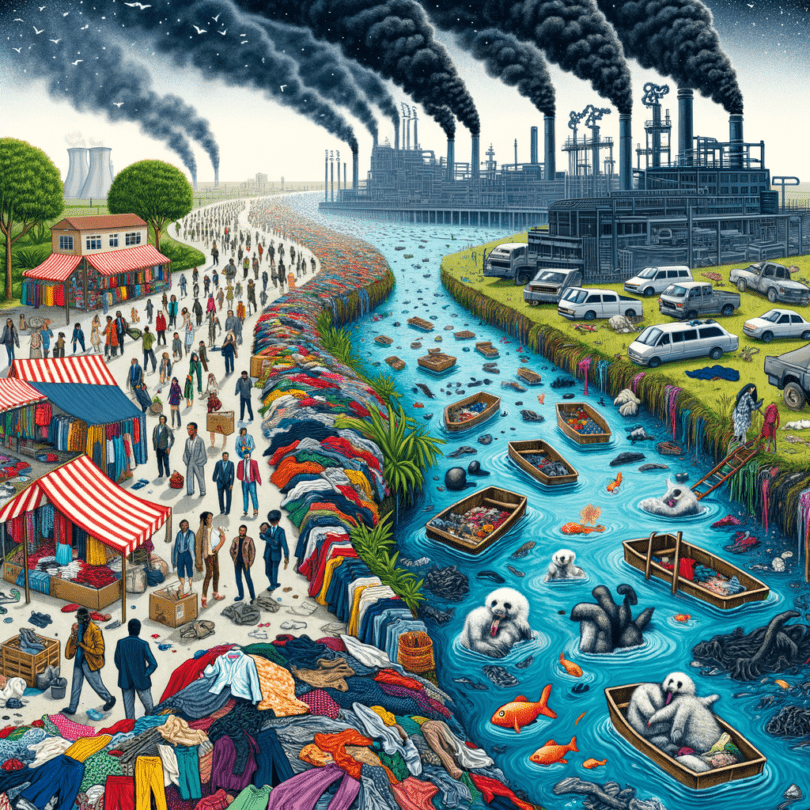Oh boy, fast fashion. It’s a term that’s bounced around in my head a lot lately—almost as rapidly as those trendy tops and shiny jeans hit the racks. Have you ever been standing in a store, clutching that oh-so-cute dress or the jeans that would look just perfect on your next night out, and wondered what it took to make it, besides just slapping a price tag on it? I’ll be honest, I’ve been swept up in those impulsive buying moments too. I mean, who doesn’t love a bargain, right? But as time went on, something started bugging me, much like realizing my deep love for tacos might be the real culprit behind my jeans feeling a tad tighter.
I was like anyone else, happily chasing trends, trawling through sales, my closet practically bursting at the seams. But once I started peeling away the layers, it hit me—fast fashion has an ugly underbelly, way more complicated and ominous than just shoving one more shirt into an already chaotic wardrobe.
So, let’s talk about how that cute little number finds its way to the store or my teetering closet. It usually starts its journey in a country far, far away (and not in the fairy-tale kind of way), often in places where environmental rules are as relaxed as my weekend plans. Picture vast fields sprayed with nasty chemicals that could scare off a skunk. Those pesticides, meant to boost crop yields, often wash into nearby waters, messing up the whole aquatic neighbourhood. Fish on a chemical bender? Sadly, it’s more real than we’d like to think.
And then there’s the water situation. Holy moly, the water used is off the charts! To give you an idea, the amount needed for a single T-shirt could keep you hydrated for, oh, about three years if you stretch it. When I sip my drink now, I half-jokingly imagine entire rivers being drained to whip up endless streams of polyester thread. Silly as it sounds, it’s almost absurd!
And the factories where these garments come together? Well, they’re often far from paradise. Many lack proper waste handling. The toxic dyes used, swimming with heavy metals, get dumped into rivers, turning clear streams into psychedelic nightmares. I picture Mother Earth weeping as a burst of artificial blue and red pollute her waters.
But wait, what about the people? Behind these threads are real folks, clocking in long hours in jam-packed factories, earning peanuts. We don’t often hear their stories, much like faint whispers outside a noisy concert. Their reality is overshadowed by the flashing lights of fashion fame—a tough price to pay for the shirts we might wear once and then toss aside.
Think about how these clothes hop across continents, leaving a carbon footprint as big as my closet on laundry day. Trucks, ships, and airplanes add to a swirling mess of pollutants, warming the planet and wreaking environmental havoc—all so we can wear that new blouse while sipping lattes.
And here’s where things hit home hard for me: when those clothes lose their allure and trends shift, they end up in landfills. And oh, those landfills are anything but pleasant. Natural fabrics take years to break down, while synthetics? They hang around for centuries—like the party guest who flat-out won’t leave.
These towering heaps of discarded garments release greenhouse gases as they sit, fueling climate chaos. It’s like the earth fires back with unpredictable weather—blistering summers, bitterly cold winters, leaving a shiver that goes straight to the bone.
So, is there hope at the end of this fashion faux-pas? The pessimist in me, fueled by countless documentaries, sometimes paints a rather gloomy picture. But the hopeful little optimist buried inside whispers a different tune—a tune that hints at a growing shift towards conscious shopping. Folks, myself included, start to think that a solid change could just be on the horizon. Perhaps, just perhaps, we can craft a sustainable cycle—one that sews more joy into every fabric than guilt.
By backing ethical brands, recycling, even upcycling those forgotten gems, we might just change the script on fashion. Maybe the biggest win comes from reminding ourselves (and our pals) that fashion twists and turns much like those old-school disco moves. Quality should trump quantity, just like knowing when to sit out another spin of a tired tune.
So next time you find yourself deliberating in front of a store rack, try to see beyond the fabric. Each piece holds a story, likely longer than its hem. Remember the journey and the cost—both seen and unseen. Let it give your conscience a gentle nudge like it has with mine, and hope for a brighter, kinder fashion world.

